Characterizing Risks for Wildfires and Prescribed Fires in the Great Plains
Abstract
1. Introduction
2. Materials and Methods
2.1. Wildfire Data
2.2. Prescribed Fire Data
2.3. Long-Term and Mid-Term Risk Factors
3. Results
3.1. Wildfire Statistics
3.2. KBDI vs. Annual Wildfires in the Great Plains
3.3. Grass Curing vs. Monthly Wildfire in Oklahoma
3.4. Prescribed Fires vs. Wildfires in the Flint Hills Region
4. Discussion
4.1. General Trends of Wildfires in the Great Plains
4.2. Seasonal Pattern of Wildfires in the Great Plains
4.3. Long-Term, Mid-Term, and Short-Term Risk Factors
4.4. Relationship Between Wildfires and Prescribed Fires
5. Conclusions
Author Contributions
Funding
Institutional Review Board Statement
Informed Consent Statement
Data Availability Statement
Acknowledgments
Conflicts of Interest
Abbreviations
| GFDI | Grassland Fire Danger Index |
| ha | hectares |
| KBDI | Keetch–Byram Drought Index |
| MODIS | Moderate-Resolution Imaging Spectroradiometer |
| NASA | National Aeronautics and Space Administration |
| NDVI | Normalized Difference Vegetation Index |
| WUI | wildland–urban interface |
References
- Ojima, D.S.; Conant, R.T.; Parton, W.J.; Lackett, J.M.; Even, T.L. Recent climate changes across the Great Plains and implications for natural resource management practices. Rangel. Ecol. Manag. 2021, 78, 180–190. [Google Scholar] [CrossRef]
- Stubbendieck, J.; Volesky, J.D.; Ortmann, J. Grassland Management with Prescribed Fire; Nebraska Forest Service Publications 42; University of Nebraska-Lincoln: Lincoln, NE, USA, 2007; Available online: https://digitalcommons.unl.edu/nebforestpubs/42 (accessed on 12 April 2025).
- Reid, A.M. Conservation and Fire Management of Great Plains Landscapes. Doctoral Thesis, Oklahoma State University, Stillwater, OK, USA, 2009. [Google Scholar]
- Russell, A.; Fontana, N.; Hoecker, T.; Kamanu, A.; Majumder, R.; Stephens, J.; Young, A.M.; Cravens, A.E.; Giardina, C.; Hiers, K.; et al. A fire-use decision model to improve the United States’ wildfire management and support climate change adaptation. Cell Rep. Sustain. 2024, 1, 100125. [Google Scholar] [CrossRef]
- Brunson, M. Public perceptions and tradeoffs in using prescribed fire to reduce wildfire risk. West. Econ. Forum 2023, 16, 53–64. [Google Scholar] [CrossRef]
- Yu, G.; Feng, Y.; Wang, J.; Wright, D.B. Performance of fire danger indices and their utility in predicting future wildfire danger over the conterminous United States. Earth’s Future 2023, 11, e2023EF003823. [Google Scholar] [CrossRef]
- Higgins, K.F.; Kruse, A.D.; Piehl, J.L. Prescribed Burning Guidelines in the Northern Great Plains. U.S. Fish and Wildlife Service; South Dakota State University Cooperative Extension Service: Brookings, SD, USA, 1989; Available online: http://openprairie.sdstate.edu/extension_circ/430 (accessed on 12 April 2025).
- Leis, S.A. Fuels management in the Great Plains. GPE Publ. 2013, 28. Available online: https://gpfirescience.org/wp-content/uploads/2022/05/GPEFuelsManLeis201328-3.pdf (accessed on 12 April 2025).
- Watts, M.; Russell, A.; Adhikari, S.; Weir, J.; Joshi, O. Analysis of the cost and cost components of conducting prescribed fires in the Great Plains. Rangel. Ecol. Manag. 2024, 92, 146–153. [Google Scholar] [CrossRef]
- Kreuter, U.P.; Treadwell, M.L.; Wonkka, C.L.; Toledo, D.; Stroman, D.L.; Twidwell, D. Fighting wildfire with prescribed fire in the Southern Great Plains, USA: Liability, regulatory and social factors. IGC Proc. (1989–2023) 2021, 28. [Google Scholar]
- Clark, A.S.; McGranahan, D.A.; Geaumont, B.A.; Wonkka, C.L.; Ott, J.P.; Kreuter, U.P. Barriers to prescribed fire in the US Great Plains, Part I: Systematic review of socio-ecological research. Land 2022, 11, 1521. [Google Scholar] [CrossRef]
- Hanberry, B.; Reeves, M.C.; Brischke, A.; Hannemann, M.; Hudson, T.; Mayberry, R.; Ojima, D.; Prendeville, H.R.; Rangwala, I. Managing effects of drought in the Great Plains. In Effects of Drought on Forests and Rangelands in the United States: Translating Science into Management Responses; Gen. Tech. Rep. WO-98; Vose, J.M., Peterson, D.L., Luce, C.H., Patel-Weynand, T., Eds.; USDA Forest Service: Washington, DC, USA, 2019; pp. 141–164. [Google Scholar]
- Huffman, M.R. Making a world of difference in fire and climate change. Fire Ecol. 2014, 10, 90–101. [Google Scholar] [CrossRef]
- Chiodi, A.M.; Larkin, N.S.; Varner, J.M. An analysis of Southeastern US prescribed burn weather windows: Seasonal variability and El Niño associations. Int. J. Wildl. Fire 2018, 27, 176–189. [Google Scholar] [CrossRef]
- Yurkonis, K.A.; Dillon, J.; McGranahan, D.A.; Toledo, D.; Goodwin, B.J. Seasonality of prescribed fire weather windows and predicted fire behavior in the northern Great Plains, USA. Fire Ecol. 2019, 15, 7. [Google Scholar] [CrossRef]
- Akinbile, D.S.; Liu, Z.; Lin, X.; Moore, T.; Song, W. Optimum weather conditions for prescribed burning in the Flint Hills Region. J. ASABE 2023, 66, 647–656. [Google Scholar] [CrossRef]
- Schreck, M.B.; Howerton, P.J.; Cook, K.R. Adapting Australia’s grassland fire danger index for the United States’ central plains. In Central Region Technical Attachment; National Weather Service: Silver Spring, MD, USA, 2010; p. 10-02. Available online: https://www.weather.gov/media/crh/publications/TA/TA_1002.pdf (accessed on 12 April 2025).
- Short, K.C. Spatial Wildfire Occurrence Data for the United States, 1992–2020 [FPA FOD 20221014]; Forest Service Research Data Archive: Fort Collins, CO, USA, 2022. [Google Scholar] [CrossRef]
- Walker, K. tigris: An R Package to Access and Work with Geographic Data from the US Census Bureau. R J. 2016, 8, 231. [Google Scholar] [CrossRef]
- Pebesma, E. Simple Features for R: Standardized Support for Spatial Vector Data. R J. 2018, 10, 439. [Google Scholar] [CrossRef]
- Remer, L.A.; Kaufman, Y.J.; Tanré, D.; Mattoo, S.; Chu, D.A.; Martins, J.V.; Li, R.R.; Ichoku, C.; Levy, R.C.; Kleidman, R.G.; et al. The MODIS aerosol algorithm, products, and validation. J. Atmos. Sci. 2005, 62, 947–973. [Google Scholar] [CrossRef]
- Keetch, J.J.; Byram, G.M. A drought index for forest fire control. In USDA Forest Service Research Paper SE-38; Southeastern Forest Experiment Station: Asheville, NC, USA, 1968. [Google Scholar]
- Krueger, E.S.; Levi, M.R.; Achieng, K.O.; Bolten, J.D.; Carlson, J.D.; Coops, N.C.; Holden, Z.A.; Magi, B.I.; Rigden, A.J.; Ochsner, T.E. Using soil moisture information to better understand and predict wildfire danger: A review of recent developments and outstanding questions. Int. J. Wildl. Fire 2022, 32, 111–132. [Google Scholar] [CrossRef]
- Plucinski, M.P.; Tartaglia, E.; Huston, C.; Stephenson, A.G.; Dunstall, S.; McCarthy, N.F.; Deutsch, S. Exploring the influence of the Keetch–Byram Drought Index and McArthur’s Drought Factor on wildfire incidence in Victoria, Australia. Int. J. Wildl. Fire 2023, 33, 1–9. [Google Scholar] [CrossRef]
- Sullivan, A.L. Grassland fire management in future climate. United_Nation_2021_Wildfires—A growing concern for sustainable development. Adv. Agron. 2010, 106, 173–208. [Google Scholar] [CrossRef]
- Anderson, S.A.; Anderson, W.R.; Hollis, J.J.; Botha, E.J. A simple method for field-based grassland curing assessment. Int. J. Wildl. Fire 2011, 20, 804–814. [Google Scholar] [CrossRef]
- Newnham, G.J.; Verbesselt, J.; Grant, I.F.; Anderson, S.A. Relative Greenness Index for assessing curing of grassland fuel. Remote Sens. Environ. 2011, 115, 1456–1463. [Google Scholar] [CrossRef]
- Donovan, V.M.; Wonkka, C.L.; Wedin, D.A.; Twidwell, D. Land-use type as a driver of large wildfire occurrence in the US Great Plains. Remote Sens. 2020, 12, 1869. [Google Scholar] [CrossRef]
- Scasta, J.D.; Weir, J.R.; Stambaugh, M.C. Droughts and wildfires in western U.S. rangelands. Rangelands 2016, 38, 197–203. [Google Scholar] [CrossRef]
- Dennison, P.E.; Brewer, S.C.; Arnold, J.D.; Moritz, M.A. Large wildfire trends in the western United States, 1984–2011. Geophys. Res. Lett. 2014, 41, 2928–2933. [Google Scholar] [CrossRef]
- Iglesias, V.; Balch, J.K.; Travis, W.R. U.S. fires became larger, more frequent, and more widespread in the 2000s. Sci. Adv. 2022, 8, eabc0020. [Google Scholar] [CrossRef]
- Westerling, A.L. Increasing western U.S. forest wildfire activity: Sensitivity to changes in the timing of spring. Philos. Trans. R. Soc. B Biol. Sci. 2016, 371, 20150178. [Google Scholar] [CrossRef]
- Boisramé, G.F.; Brown, T.J.; Bachelet, D.M. Trends in western USA fire fuels using historical data and modeling. Fire Ecol. 2022, 18, 8. [Google Scholar] [CrossRef]
- Donovan, V.M.; Wonkka, C.L.; Twidwell, D. Surging wildfire activity in a grassland biome. Geophys. Res. Lett. 2017, 44, 5986–5993. [Google Scholar] [CrossRef]
- Lang, Y.; Moeini-Meybodi, H. Wildfires—A Growing Concern for Sustainable Development; United Nations Department of Economic and Social Affairs: New York, NY, USA, 2021; Available online: https://www.un.org/development/desa/dpad/wp-content/uploads/sites/45/publication/PB_111.pdf (accessed on 12 April 2025).
- Gamelin, B.L.; Feinstein, J.; Wang, J.; Bessac, J.; Yan, E.; Kotamarthi, V.R. Projected U.S. drought extremes through the twenty-first century with vapor pressure deficit. Sci. Rep. 2022, 12, 8615. [Google Scholar] [CrossRef]
- Cooke, B.; Williams, D.; Paveglio, T.; Carroll, M. Living with fire: How social scientists are helping wildland-urban interface communities reduce wildfire risk. Sci. You Can Use Bull. 2016, 19, 9. [Google Scholar]
- Brotons, L.; Aquilué, N.; De Cáceres, M.; Fortin, M.J.; Fall, A. How fire history, fire suppression practices and climate change affect wildfire regimes in Mediterranean landscapes. PLoS ONE 2013, 8, e62392. [Google Scholar] [CrossRef]
- Balch, J.K.; Bradley, B.A.; Abatzoglou, J.T.; Nagy, R.C.; Fusco, E.J.; Mahood, A.L. Human-started wildfires expand the fire niche across the United States. Proc. Natl. Acad. Sci. USA 2017, 114, 2946–2951. [Google Scholar] [CrossRef]
- Dolling, K.; Chu, P.S.; Fujioka, F. A climatological study of the Keetch/Byram drought index and fire activity in the Hawaiian Islands. Agric. For. Meteorol. 2005, 133, 17–27. [Google Scholar] [CrossRef]
- Brown, E.K.; Wang, J.; Feng, Y. U.S. wildfire potential: A historical view and future projection using high-resolution climate data. Environ. Res. Lett. 2021, 16, 034060. [Google Scholar] [CrossRef]
- Abatzoglou, J.T.; Williams, A.P. Impact of anthropogenic climate change on wildfire across the western U.S. forests. Proc. Natl. Acad. Sci. USA 2016, 113, 11770–11775. [Google Scholar] [CrossRef] [PubMed]
- Wade, D. Fuel moisture and prescribed burning. South. Fire Exch. Fact Sheet 2013, 5, 5–8. Available online: https://southernfireexchange.org/wp-content/uploads/2013-5.pdf (accessed on 12 April 2025).
- Toledo, D.; Kreuter, U.P.; Sorice, M.G.; Taylor, C.A., Jr. The role of prescribed burn associations in the application of prescribed fires in rangeland ecosystems. J. Environ. Manag. 2014, 132, 323–328. [Google Scholar] [CrossRef]
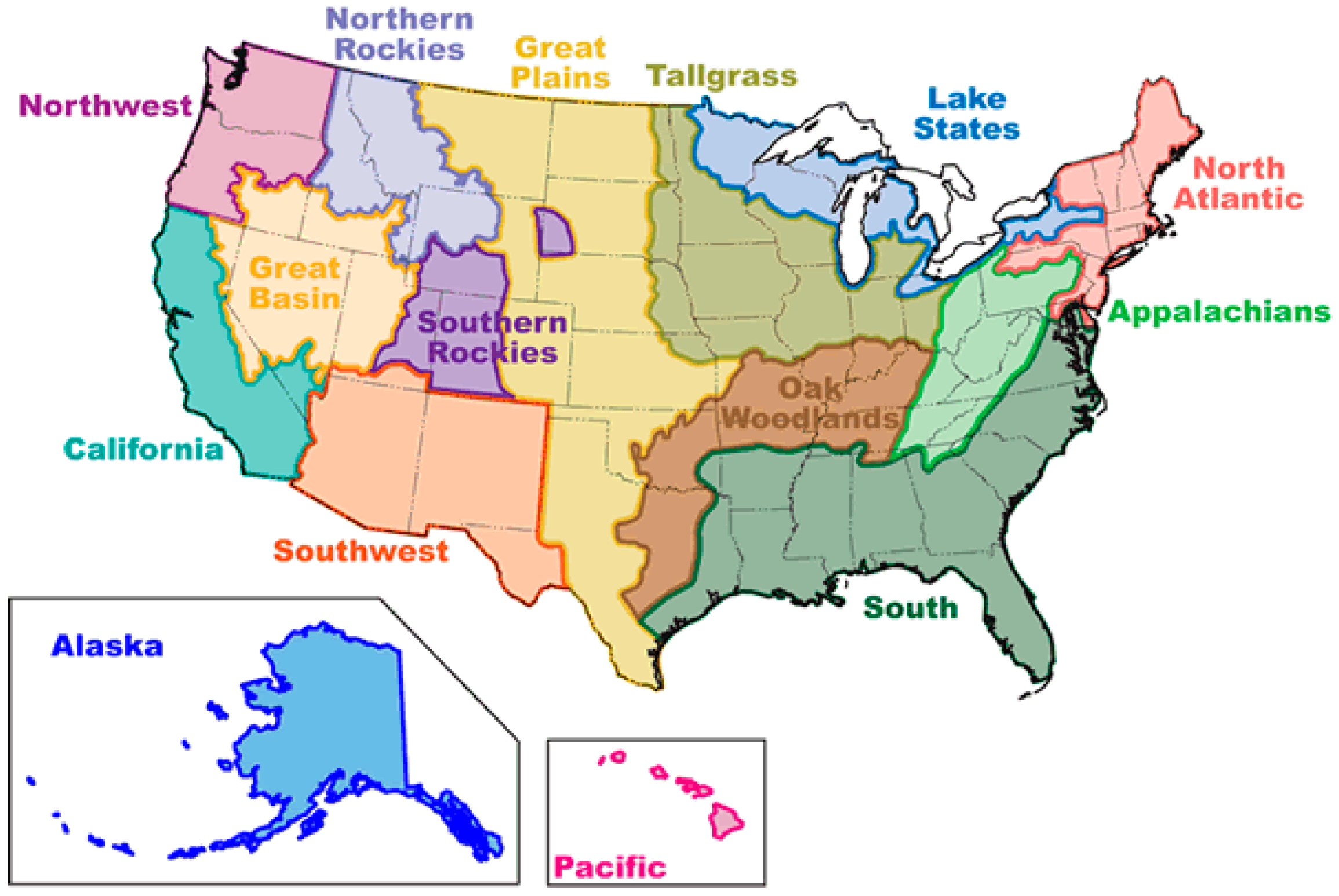
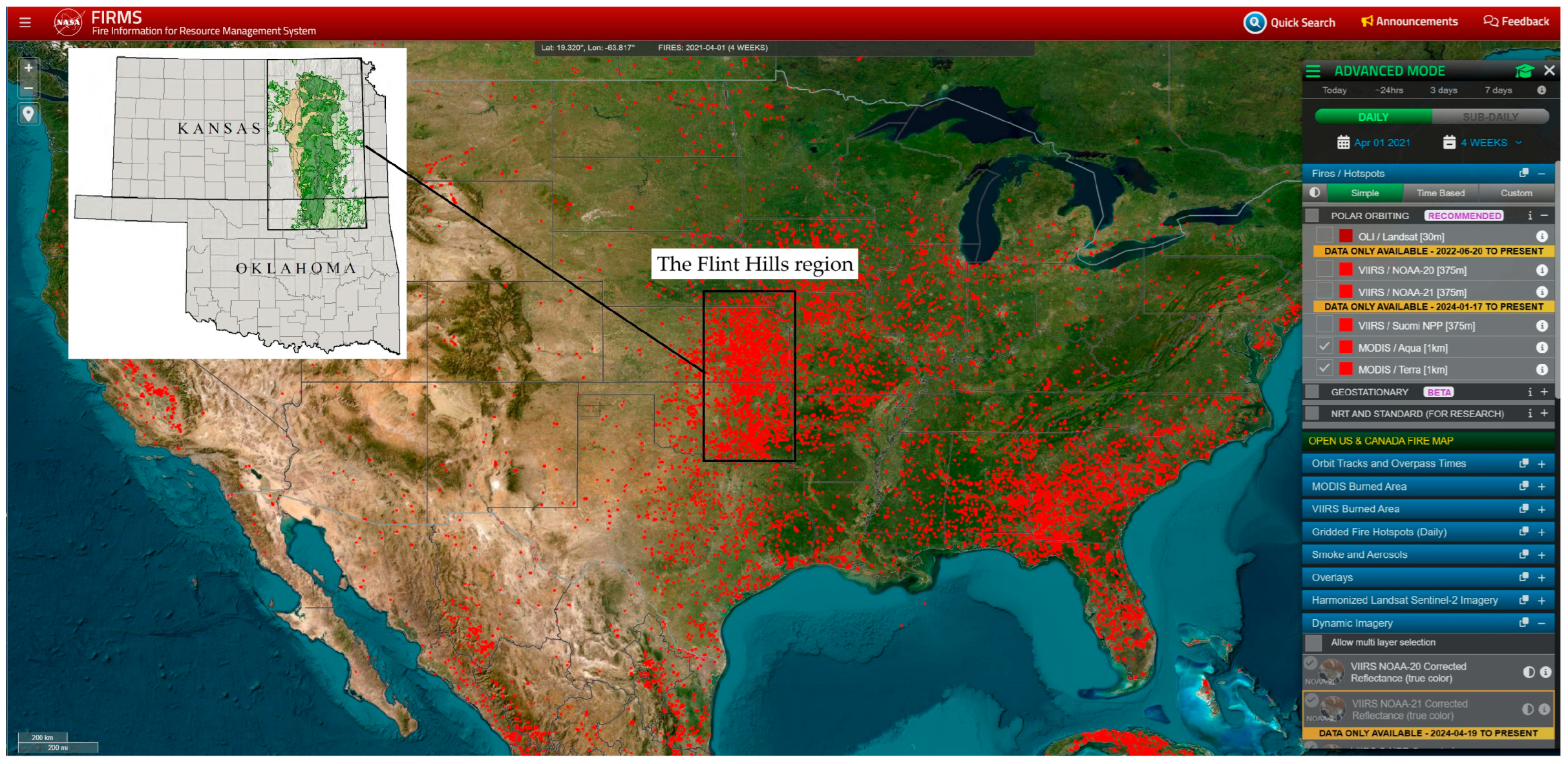
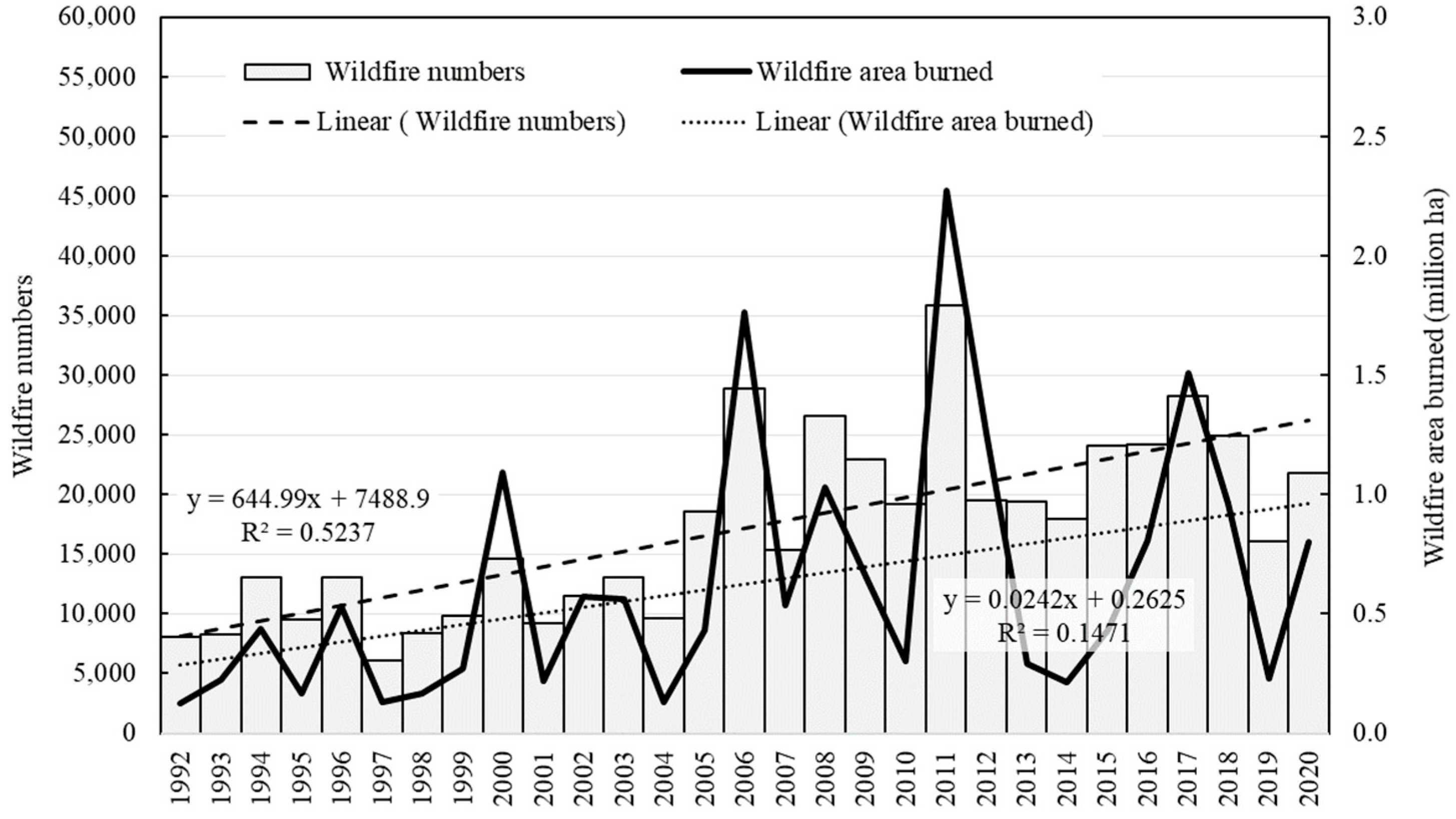

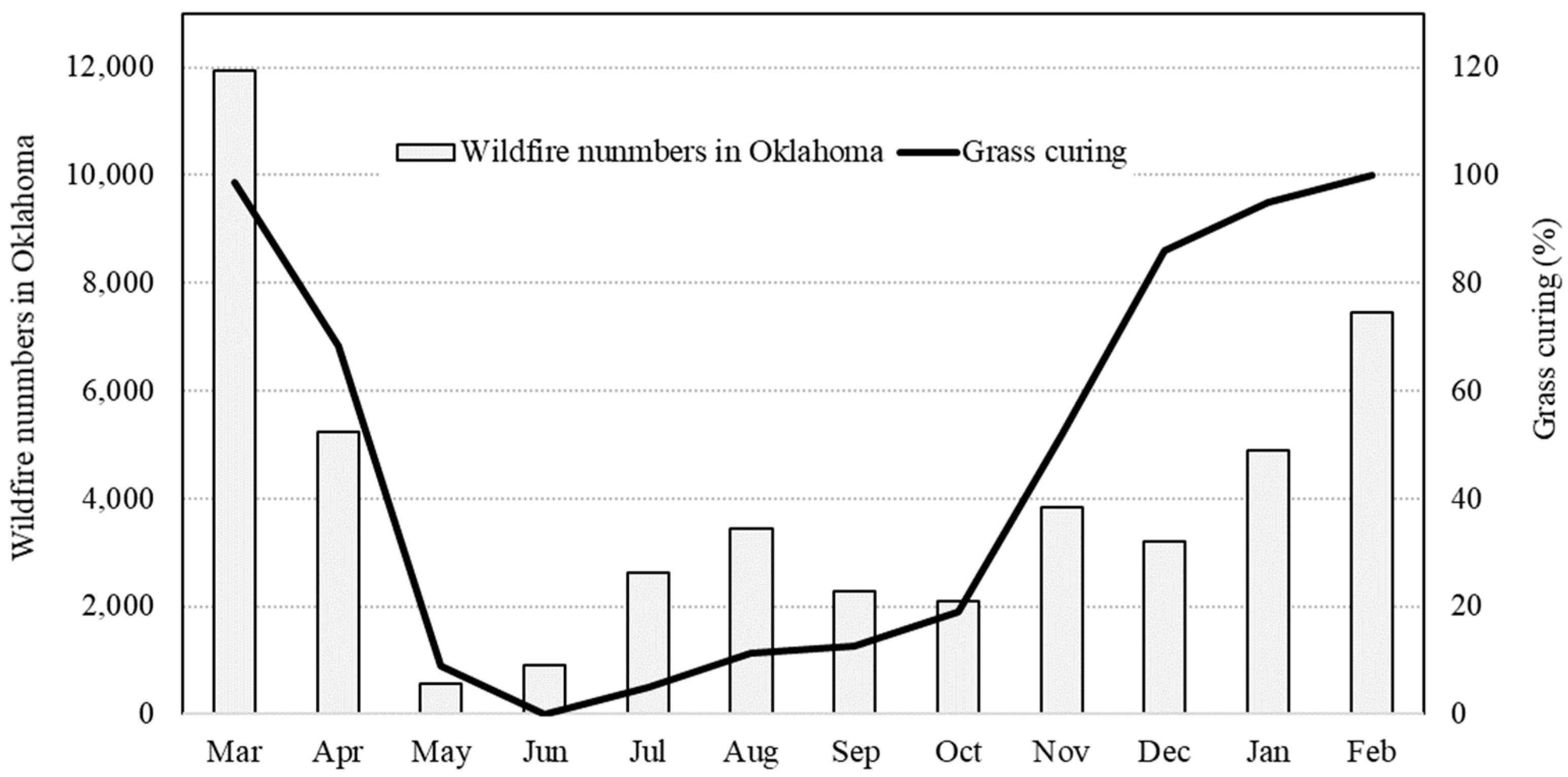

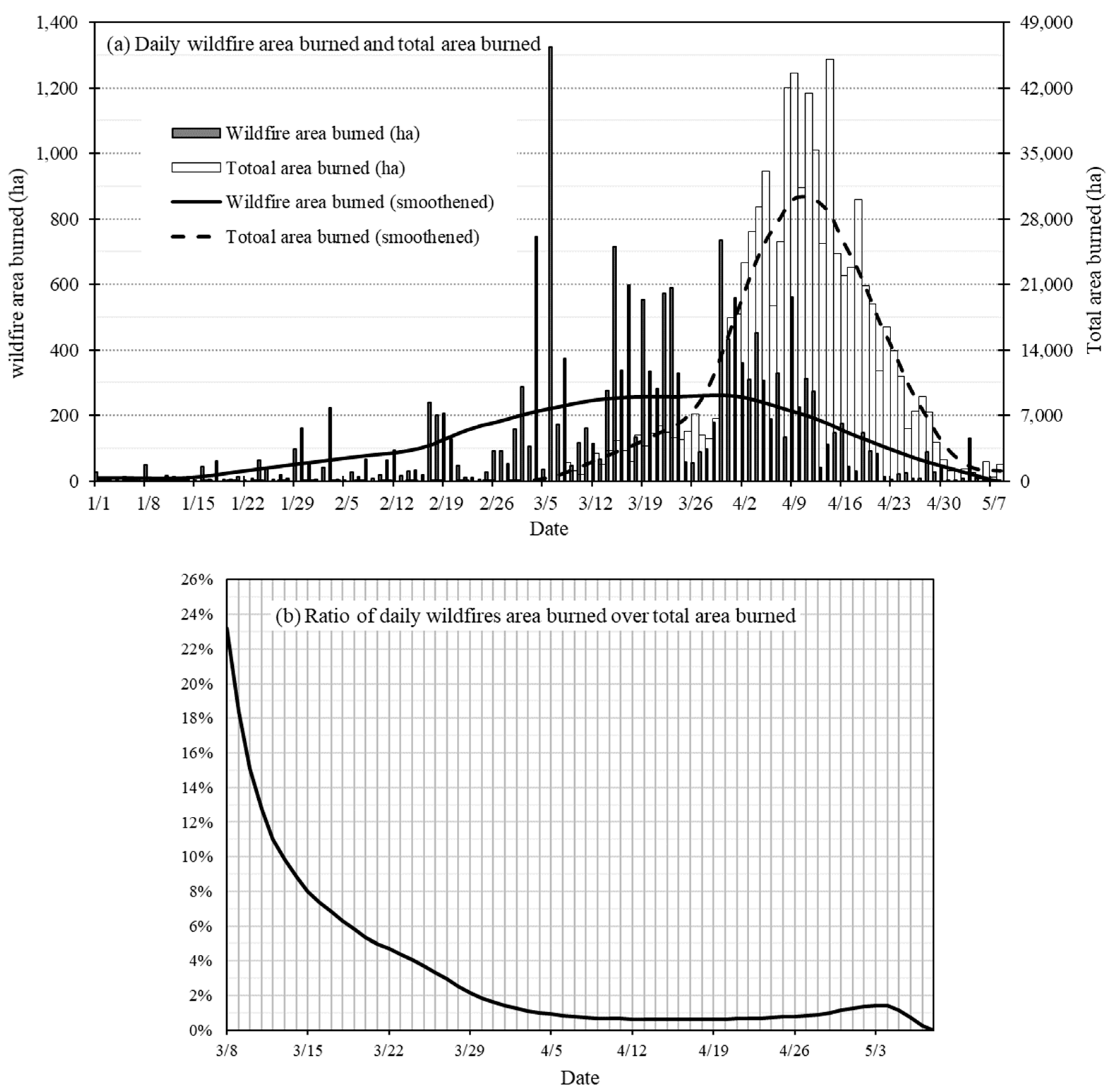
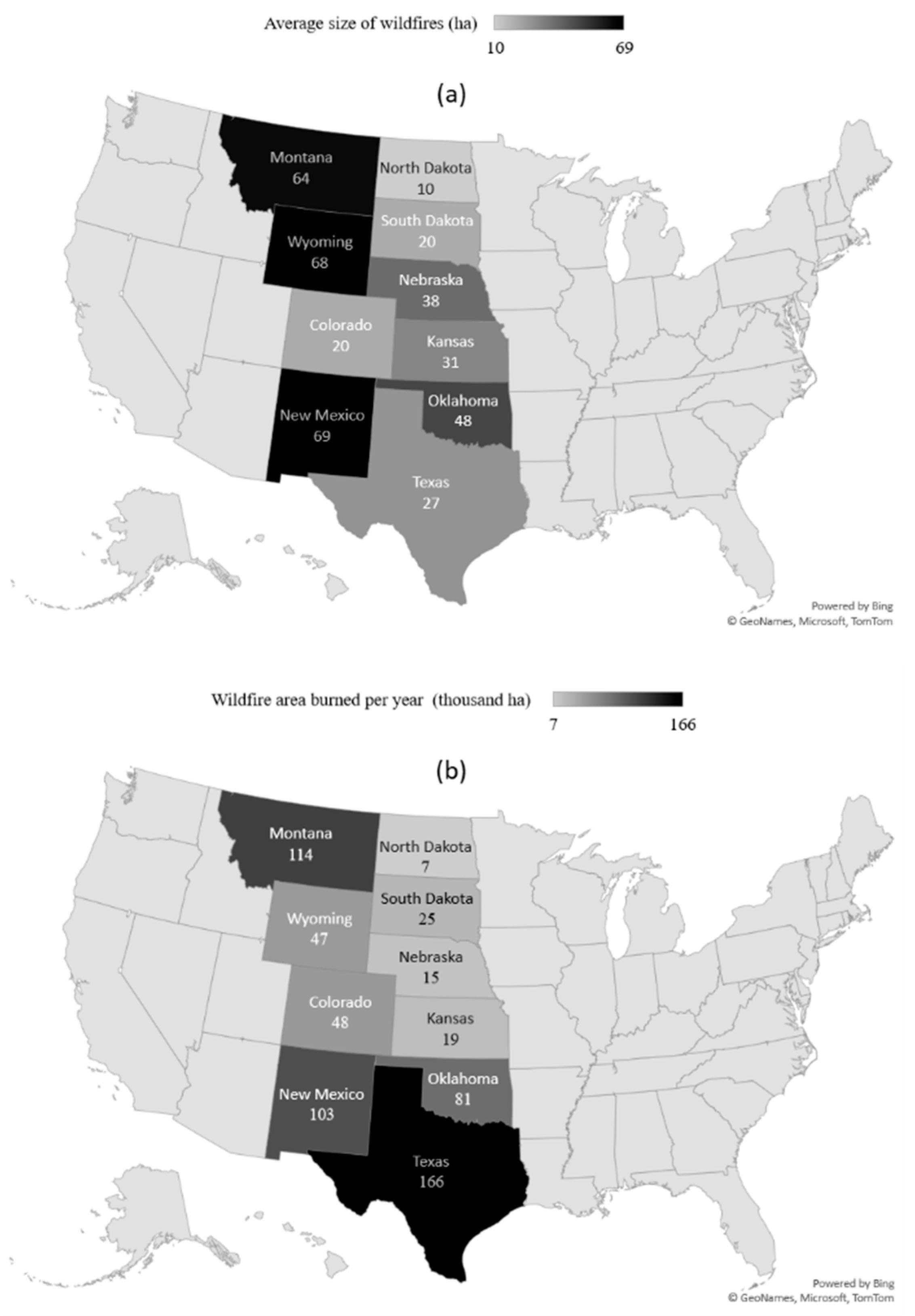

| State | Total Fire Count | Total Burned Area (ha) | Area Burned per Year (Thousand ha) | Average Fire Size per Count (ha) | Average Fire Count per Year |
|---|---|---|---|---|---|
| Colorado | 68,313 | 1,379,834 | 48 | 20 | 2356 |
| Kansas | 18,275 | 562,291 | 19 | 31 | 630 |
| Montana | 51,804 | 3,312,605 | 114 | 64 | 1786 |
| North Dakota | 19,834 | 198,103 | 7 | 10 | 684 |
| Nebraska | 11,625 | 441,661 | 15 | 38 | 401 |
| New Mexico | 43,466 | 2,994,334 | 103 | 69 | 1499 |
| Oklahoma | 48,495 | 2,339,363 | 81 | 48 | 1672 |
| South Dakota | 36,165 | 718,740 | 25 | 20 | 1247 |
| Texas | 179,791 | 4,818,406 | 166 | 27 | 6200 |
| Wyoming | 19,981 | 1,353,126 | 47 | 68 | 689 |
| Total | 497,749 | 18,118,463 | 625 | 36 | 17,164 |
Disclaimer/Publisher’s Note: The statements, opinions and data contained in all publications are solely those of the individual author(s) and contributor(s) and not of MDPI and/or the editor(s). MDPI and/or the editor(s) disclaim responsibility for any injury to people or property resulting from any ideas, methods, instructions or products referred to in the content. |
© 2025 by the authors. Licensee MDPI, Basel, Switzerland. This article is an open access article distributed under the terms and conditions of the Creative Commons Attribution (CC BY) license (https://creativecommons.org/licenses/by/4.0/).
Share and Cite
Liu, Z.; Okafor, I.O.; George, M.B. Characterizing Risks for Wildfires and Prescribed Fires in the Great Plains. Fire 2025, 8, 235. https://doi.org/10.3390/fire8060235
Liu Z, Okafor IO, George MB. Characterizing Risks for Wildfires and Prescribed Fires in the Great Plains. Fire. 2025; 8(6):235. https://doi.org/10.3390/fire8060235
Chicago/Turabian StyleLiu, Zifei, Izuchukwu Oscar Okafor, and Mayowa Boluwatife George. 2025. "Characterizing Risks for Wildfires and Prescribed Fires in the Great Plains" Fire 8, no. 6: 235. https://doi.org/10.3390/fire8060235
APA StyleLiu, Z., Okafor, I. O., & George, M. B. (2025). Characterizing Risks for Wildfires and Prescribed Fires in the Great Plains. Fire, 8(6), 235. https://doi.org/10.3390/fire8060235







